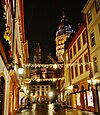
Back Mainz Afrikaans Mainz ALS ማይንጽ Amharic Maganza AN ماينتس Arabic ماينتس ARZ Mainz AST Mainz Aymara Mayns Azerbaijani ماینتس AZB
Mainz
| |
|---|---|
View of Mainz Cathedral from Wiesbaden Houses on Market Square Old Town Judensand (Jews' Sand) cemetery | |
|
| |
| Coordinates: 49°59′58″N 08°16′25″E / 49.99944°N 8.27361°E | |
| Country | Germany |
| State | Rhineland-Palatinate |
| District | Urban district |
| Founded | 13/12 BC |
| Subdivisions | 15 boroughs |
| Government | |
| • Lord mayor (2023–31) | Nino Haase[1] (Ind.) |
| Area | |
• Total | 97.75 km2 (37.74 sq mi) |
| Highest elevation | 285 m (935 ft) |
| Lowest elevation | 85 m (279 ft) |
| Population (2022-12-31)[2] | |
• Total | 220,552 |
| • Density | 2,300/km2 (5,800/sq mi) |
| Time zone | UTC+01:00 (CET) |
| • Summer (DST) | UTC+02:00 (CEST) |
| Postal codes | 55116–55131 |
| Dialling codes | 06131, 06136 |
| Vehicle registration | MZ |
| Website | www.mainz.de |
| Official name | ShUM Sites of Speyer, Worms and Mainz |
| Type | Cultural |
| Criteria | (ii)(iii)(vi) |
| Designated | 2021 |
| Reference no. | [1] |
Mainz (German: [maɪnts] ; see below) is the capital and largest city of the German state of Rhineland-Palatinate, and with around 223,000 inhabitants,[3] it is Germany's 35th-largest city. It lies in the Rhine-Main Metropolitan Region—Germany's second-largest metropolitan region after Rhine-Ruhr—which also encompasses the cities of Frankfurt am Main, Wiesbaden, Darmstadt, Offenbach am Main, and Hanau.
Mainz is located at the northern end of the Upper Rhine Plain, on the left bank of the Rhine, opposite the Hessian capital of Wiesbaden and the mouth of the River Main into the Rhine. It is the largest city of Rhenish Hesse, a region of Rhineland-Palatinate that was historically part of Hesse, and is one of Germany's most important wine regions because of its mild climate. Mainz is connected to Frankfurt am Main by the Rhine-Main S-Bahn rapid transit system. Before 1945, Mainz had six boroughs on the other side of the Rhine (see: de:Rechtsrheinische Stadtteile von Mainz). Three have been incorporated into Wiesbaden (see: de:AKK-Konflikt), and three are now independent.
Mainz was founded as Castrum Mogontiacum by Roman general Nero Claudius Drusus in the 1st century BC on the northern frontier of the Roman Empire, and became the capital of the Roman province of Germania Superior. The city was settled by the Franks from 459 on, and in the 8th century it became an important city within the Holy Roman Empire, as capital of the Electorate of Mainz and seat of the Archbishop-Elector of Mainz, the primate of Germany. Mainz Cathedral is one of the three Rhenish Imperial Cathedrals along with Speyer Cathedral and Worms Cathedral.
Since the 12th century, Mainz was one of the ShUM-cities—a league formed by the cities of Speyer, Worms and Mainz—which are referred to as the cradle of Ashkenazi Jewish life and as the center of Jewish life during Medieval times. The Jewish heritage of these cities is one of a kind, and has been declared the UNESCO World Heritage Site of "ShUM Sites of Speyer, Worms and Mainz",[4] which includes the Judensand (Jews' Sand), the second-oldest Jewish cemetery in Europe after the Heiliger Sand in Worms.
Mainz is the birthplace of Johannes Gutenberg, who introduced letterpress printing to Europe with his movable type printing press, starting the global spread of the printing press, and in the early 1450s manufactured his first books in the city, including the Gutenberg Bibles, two of which are kept at the city's Gutenberg Museum. Mainz was heavily damaged in World War II; more than 30 air raids destroyed around half of the old town in the city centre, but many buildings were rebuilt post-war.
Like most cities in the Rhineland, Mainz holds extensive carnival celebrations, that are known as the second-most important in Germany, after the celebrations in Cologne. The borough of Lerchenberg is the seat of ZDF (Zweites Deutsches Fernsehen, lit. "Second German Television"), the second-most important German public service television broadcaster, as well as of 3sat, another television broadcaster, that is jointly operated by public broadcasters from Germany (ARD and ZDF), Austria (ORF), and Switzerland (SRG SSR).
- ^ Wahl der Oberbürgermeister der kreisfreien Städte, Landeswahlleiter Rheinland-Pfalz. Retrieved 5 July 2023.
- ^ "Bevölkerungsstand 2022, Kreise, Gemeinden, Verbandsgemeinden" (PDF) (in German). Statistisches Landesamt Rheinland-Pfalz. 2023.
- ^ "Einwohner der Landeshauptstadt Mainz laut Melderegister am 31.12.2023 (zum Stichtag erstellt am 15.02.2024)" (PDF). Landeshauptstadt Mainz. Retrieved 23 July 2024.
- ^ Centre, UNESCO World Heritage. "ShUM Sites of Speyer, Worms and Mainz". UNESCO World Heritage Centre. Archived from the original on 22 August 2016. Retrieved 14 April 2022.












